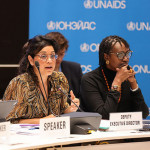The following is an excerpt from the 2016 annual report to Congress from the U.S. President’s Emergency Fund for AIDS Relief (PEPFAR).
Achieving an AIDS-Free Generation Is Possible, but the Time to Act Is Now
Today, thanks to our efforts and those of PEPFAR’s many partners, we have everything we need—the tools, science, shared vision—to decrease the number of new HIV infections by 90 percent. We envision the creation of an AIDS-free generation where no one is left behind, when every person diagnosed with HIV will be prioritized for treatment immediately, and when HIV is no longer a public health threat. That future is possible, but the time to act is now.
According to the Joint United Nations Programme on HIV/AIDS (UNAIDS), nearly 37 million people are living with HIV/AIDS globally. Although the current estimate of individuals on treatment for HIV (15.8 million) has doubled within the last five years—an amazing accomplishment—there is still more to do. With “business as usual,” we risk a cumulative 100 million HIV infections by 2030, which is far beyond the global community’s ability to respond.
Every week, nearly 35,000 people are infected with HIV globally. While HIV incidence has declined by 50 percent since its peak in sub-Saharan Africa, the population in the region has increased by 340 million during the same period. Due to the resulting “youth bulge” in sub-Saharan Africa, millions of young people are entering a time in life when they are most susceptible to HIV infection. In fact, Africa has the youngest population in the world, with 200 million people between 15 and 24 years of age. Given these demographic trends, we have to work hard just to keep up with, and even harder to keep ahead of, the epidemic.
It is clear that if we begin to drift, lessen our aspirations, or fail to follow the science, we will have squandered our cumulative investments and allowed the accomplishments of the last decade to unravel.
We must seize this opportunity. We have a five-year window to fast-track our efforts and thereby change the trajectory of the HIV/AIDS epidemic and create a better future. In September 2015, when the world adopted the 2030 Agenda for Sustainable Development and the Sustainable Development Goals, the global community collectively committed to a goal of ending the AIDS epidemic by 2030. President Obama made clear that the United States will lead the way by announcing bold new HIV treatment and prevention targets for PEPFAR.
By the end of 2017, PEPFAR will:
- Support 12.9 million men, women, and children with lifesaving treatment.
- Provide 13 million VMMCs.
- Reduce HIV incidence by 40 percent among adolescent girls and young women within the highest-burden geographic areas of 10 sub-Saharan African countries.
New game changing guidelines from the World Health Organization (WHO) in fall 2015 provide tremendous opportunities to prevent and treat HIV/AIDS immediately. WHO released guidance that recommends ART for all persons living with HIV irrespective of clinical or immunologic status through a “Test and Start” treatment model. This will increase the number of persons eligible for treatment, but will also provide an individual as well as population-level benefit, as persons who start ART early remain healthier and greatly reduce their risk of transmitting the virus to others.
WHO also released new service delivery guidelines that recognize the evolution in the HIV/AIDS response. Stable patients who are identified while already healthy will require fewer clinical interventions. A large number of patients who are stable on ART can be cared for with less frequent clinical visits (every six months) and less frequent medication refills (every six months). Such patients can safely receive care in their communities by lay providers, improving adherence and decongesting clinics so they may focus on the smaller group of sicker patients who need clinical care. Rapid adoption of this streamlined approach has great potential to free up resources to treat more patients in need.
Finally, WHO also released new guidance related to pre-exposure prophylaxis (PrEP) recommending that oral PrEP containing tenofovir should be offered as an additional prevention choice for people at substantial risk of HIV infection. This recommendation enables key at-risk populations to benefit from this additional prevention option.
We need to seize these opportunities working in close coordination with our partner countries and multilateral organizations to explore the implementation of these recommendations. As has been documented from the Fast-Track strategies of UNAIDS and others, the speed at which countries adopt these new policies is key to reducing new HIV infections and reducing future treatment costs. Expanding treatment eligibility to all persons living with HIV and the adoption of key service delivery recommendations in the next few months will have the greatest impact in achieving the 2020 and 2030 global goals. We can make our limited resources twice as effective with respect to lives saved and infections averted if these changes are appropriately and aggressively implemented. If implemented, we can control and ultimately reduce the out-year costs of addressing the HIV/AIDS pandemic.
The Vision for Getting It Done
To control the epidemic and, ultimately, achieve an AIDS-free generation, we must sustain and expand our collective gains. Led by our strategic vision, PEPFAR 3.0—Controlling the Epidemic: Delivering on the Promise of an AIDS-free Generation—we are using data to do the right things, in the right places, right now, and in the right way. PEPFAR 3.0 outlines our strategic focus for Phase III of the program: sustainable control of the HIV/AIDS epidemic through five action agendas.
- Impact Action Agenda—focusing resources and leveraging finances to address the most vulnerable populations and to control the epidemic.
- Efficiency Action Agenda—increasing transparency, oversight, and accountability across PEPFAR and its interagency partners to ensure every taxpayer dollar is optimally invested and tracked.
- Sustainability Action Agenda—ensuring that when the United States and partner countries have scaled up interventions and reached epidemic control, the services, systems, financing, and policies required to maintain that control are readily available to PEPFAR beneficiaries.
- Partnership Action Agenda—strengthening partnerships to achieve sustainability and ultimately create an AIDS-free generation
- Human Rights Action Agenda—securing and protecting human rights and addressing the human rights challenges of those affected by the disease.
UNAIDS’s Fast-Track strategy, which has now been adopted by many countries as their own, sets out 90-90-90 targets: 90 percent of people living with HIV know their HIV status, 90 percent of people who know their HIV status are accessing treatment, and 90 percent of people on treatment have suppressed viral loads. Together, in 2015, PEPFAR and our intergovernmental partners have made significant strides toward achieving these goals.
To read the complete report, click here.







Comments
Comments